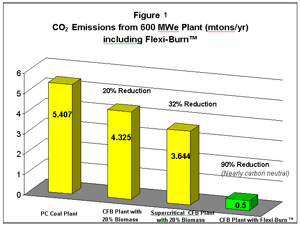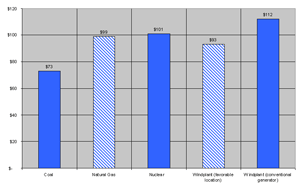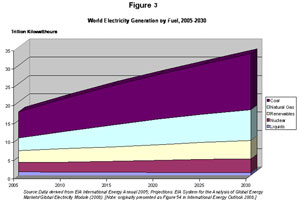
Clean Coal: What Works Now and Tomorrow
Diversifying energy sources is a key goal set out in the Obama-Biden
New Energy for America plan. Since taking over the reins of power, the new administration proposed a comprehensive plan to
- invest in alternative and renewable energy,
- end U.S. addiction to foreign oil,
- address the global climate crisis, and
- create thousands of new green energy jobs.
Supporting these goals is more than $150 billion over 10 years in clean energy and energy efficiency projects in the President's budget and a commitment to make the Research and Experimentation Tax Credit permanent. The administration expects investments in research and development today to pay off in high-quality green jobs tomorrow.
Despite these positive steps, the overall energy policy goals are extremely ambitious. Can the United States reduce its greenhouse gas (GHG) emissions by 80 percent by 2050? It is questionable whether the programs outlined so far will be able to meet these energy goals, especially in light of the current recession.
Some voices say that President Obama must strike a balance between stimulating the economy in the next few years and investing in the long-term future of the environment. One way to do that is to focus on reducing environmental impacts while improving technologies so they evolve into long-term solutions for reducing GHG emissions.
A Role for Coal
Energy Secretary Steven Chu, Ph.D., told the Committee on Energy and Natural Resources in January that, among other things, clean coal is a necessary element in planning for the future and more investment is needed for carbon capture and storage (CCS) research (Click here to see an archived Webcast of this hearing). CCS refers to capturing carbon dioxide (one of the Earth’s most abundant GHGs) from coal-fired power plants, compressing it and storing it underground, in deep-saline aquifers or other geologic formations.
The Obama-Biden administration supports incentives to accelerate investment in zero-carbon coal facilities, and the policy includes developing coal-fired plants with CCS.
A unique steam generator technology, circulating fluidized bed (CFB) reactors may have a place in meeting the goals of the U.S. energy plan. They offer an efficient way to burn coal alone or in combination with biomass, capturing pollutants and transforming the fuel’s heat into the steam used to produce power.
CFB uses fluidization technology to mix and circulate fuel particles with limestone as they burn in a low temperature combustion process. The combination of limestone and low-burning temperature removes pollutants or minimizes their formation during the burning process. Vertical-tube, supercritical steam technology allows more of the fuel’s energy to be transferred to the steam, improving overall efficiency and reducing the amount of fuel needed to generate electricity and reducing air emissions.
Due to its unique combustion process, CFBs can burn such biomass fuels as forest residue, demolition wood, saw dust, corn husks, and sugar cane. Biomass is considered carbon neutral, since it absorbs and stores carbon from the atmosphere during its growth cycle through photosynthesis. When burned, biomass releases the same carbon back to the atmosphere, resulting in nearly zero net carbon dioxide emissions to the atmosphere.
Power plants don't burn only biomass because this fuel source's supply chain is undeveloped, limiting the size of such plants to about 25-50 megawatts electrical (MWe). Under the current situation, 10 or more biomass plants would have to be built to generate a more conventional large-scale (300 MWe or larger) power plant. The scale and fuel supply limitations drives up the cost of a biomass plant 20 to 30 percent higher than that from conventional large fossil power plants. The CFB technology provides a bridge from strictly coal as a fuel source to a combination of coal and biomass that meets large-scale power demands. It can use more biomass when available or fall back on coal when it is not. This can be done today, while still producing affordable electricity. As shown in the Figure 1, a supercritical 600-MWe CFB plant burning 20 percent biomass is estimated to produce 32 percent less carbon dioxide emissions than a conventional coal plant.

Click on the graph to enlarge.
But what about those coal power days? New flexible combustion technologies currently under development hold promise for lowering both the cost and technology risk for the CCS solution. These technologies simplify the carbon dioxide capture and removal process by using a mixture of oxygen and recycled CFB flue gas to produce a carbon dioxide-rich flue gas that can be more easily captured. The technology could reduce coal plant carbon dioxide emissions to the atmosphere by more than 90 percent, according to pilot testing and demonstrations.
Demand and Supply
Obama’s plan addresses a broad range of energy users, but the one area where this subject hits closest to home – literally – is in the way electric companies generate power for residential use. Coal is the lowest cost energy source for U.S. residences (see Figure 2). Its use will steady energy prices at a time when investment and growth is needed to for the economy.
 Figure 2
Figure 2. Monthly Residential Energy Bill by Energy Source.
Click on the graph to enlarge.
Source: Average U.S. residence energy consumption of 936 kWh per month derived from the Energy Information Administration (EIA), Table 5 U.S. Average Monthly Bill by Sector, Census Division and State 2007. Cost comparison data derived from cost comparison prepared by Black & Veatch and cited in Cost Works Against Alternative and Renewable Energy Sources in Time of Recession, New York Times, March 28, 2009.
At home and abroad, the government predicts the energy demand will only grow. The U.S. Department of Energy, Energy Information Administration (EIA) forecasts that the demand between now and 2030 will increase by 50 percent, with two-thirds of the new demand likely coming from developing nations. To meet these demands, countries around the world will need to tap deeper into all the primary energy sources, including nuclear, natural gas, coal, and renewables.
The EIA forecasts show that, in the coming years, more coal and more natural gas is likely to be used than other sources because of their low cost, abundance, and lengthy supply life, coal specifically (see Figure 3). Nuclear energy will be constrained by the time it takes to build plants, get regulatory approvals, and by perceived safety concerns. Biofuels and renewable alternatives (for example, wind and solar power) will grow rapidly but will remain a relatively small contributor and will not replace significant quantities of fossil fuels in the near future.

Click on the graph to enlarge.
Our nation faces critical challenges in meeting the demand for affordable power in an era of economic uncertainty, when stimulating growth is at the top of the priority list. How can we move forward with this need to keep energy prices affordable while at the same time making progress on the ambitious environmental agenda that includes diversifying our energy sources, improving the environment, and reducing the effects of climate change? We will need to use all the tools in our arsenal, including relying on existing technologies that can provide environmentally friendly power at a cost we can handle.
What about Coal?
Coal is the most abundant primary energy source in the world, capable of supporting U.S. energy needs for more than 300 years at our current usage rate as compared to oil or natural gas, which is projected to be exhausted in about 30-50 years.
It is located in or near the largest population centers and largest industrialized countries like the United States, the United Kingdom, Germany, China, and India. It can also be easily transported and produces among the most reliable and affordable electricity today.
It also carries a significant environmental cost with its use. When coal is burned to produce electricity, it emits air pollutants in the form of oxides of sulfur, nitrogen and carbon into the atmosphere. The oxides of sulfur and nitrogen can contribute to acid rain and smog. And the oxide of carbon in the form of carbon dioxide (CO2) is a greenhouse gas that can contribute to global warming.
About the Author
Robert S. Giglio is the director of Global Marketing and Strategy for the Foster Wheeler Global Power Group. He supports the Global Sales and Marketing Group with all marketing efforts. Giglio is a power industry expert. An MSME graduate of the Massachusetts Institute of Technology in Cambridge, Mass., Giglio has been with the company since 1994.